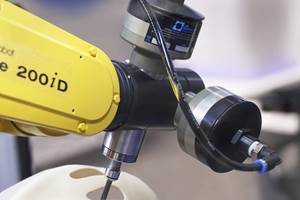Understanding Surface Location Error
Change your speed by a few hundred rpm and the tool’s effective cutting radius may change.
Share






Many shops milling at high spindle speeds understand why it is that a small change in speed can dramatically improve the depth of cut. The explanation has to do with chatter, and the tendency of a high speed spindle to “harmonize” in certain narrow zones along the rpm range. Pick a speed that corresponds to one of these stable zones and the chatter will quiet down, allowing the tool to take a heavier cut.
But even those shops that are proficient at avoiding chatter in this way may fall victim to a related hazard. The tool that is no longer chattering is still vibrating. In fact, the tool is likely to vibrate with even greater amplitude when the chatter is quiet, because the low-chatter spindle speeds occur near those “natural frequencies” where the system inherently wants to vibrate. And this vibration can affect the cutting diameter of the tool.
In other words, a variety of run-out may come from the spindle speed alone. A thin wall milled to be 0.065 inch thick at 13,000 rpm might be only 0.061 inch thick at 14,000 rpm, because the vibration added an error of 0.002 inch on either side. In both cases, the machine, the cutter and the tool paths were all identical. Only the spindle speed changed, and this was enough to cause the surface to land in a different place. The term for this phenomenon is “surface location error.”
Avoiding The Error
The phenomenon has always been there, but high speed machining makes it conspicuous. The example involving the thin wall is realistic for a couple of reasons. For one, shops accustomed to identifying their own low-chatter speeds tend to serve the aircraft industry, machining thin-walled parts out of solid aluminum. Also, the magnitude of the error in that example—0.002 inch for a speed change of 1,000 rpm—is typical of the error that has been measured in tests involving representative high speed milling equipment.
One of the researchers studying machine tool surface location error is Philip Bayly, a professor of mechanical engineering at Washington University in St. Louis, Missouri. Dr. Bayly and others here are working to develop an analysis method called “time finite element analysis” that is able to predict both stability and surface location error at the same time. For a given combination of spindle and tooling, this time FEA method can be used to find the optimum spindle speed that both maximizes stability and minimizes error. This prediction was possible before, but the time FEA method performs the computation quickly enough that the analysis might one day be incorporated into software that runs on the shop floor.
But even without this software, Dr. Bayly says shops can still manage the error. One characteristic of this error is that it tends to occur within an rpm range that is even narrower than a chatter-free stable machining range. That means it should be possible to avoid the error and yet still remain free of chatter simply by adjusting the speed setting up or down from where the error occurs. A change of 100 or 200 rpm may be sufficient.
The most important step is simply to recognize the error when it occurs. While it is easy to blame the dimensional error on the setup or some other more familiar source of variability, the error in a tightly controlled process may be the result of the spindle speed instead.
Related Content
How to Accelerate Robotic Deburring & Automated Material Removal
Pairing automation with air-driven motors that push cutting tool speeds up to 65,000 RPM with no duty cycle can dramatically improve throughput and improve finishing.
Read MoreRead Next
AMRs Are Moving Into Manufacturing: Considerations for Implementation
AMRs can provide a flexible, easy-to-use automation platform so long as manufacturers choose a suitable task and prepare their facilities.
Read MoreMachine Shop MBA
Making Chips and 91ĘÓƵÍřŐľÎŰ are teaming up for a new podcast series called Machine Shop MBA—designed to help manufacturers measure their success against the industry’s best. Through the lens of the Top Shops benchmarking program, the series explores the KPIs that set high-performing shops apart, from machine utilization and first-pass yield to employee engagement and revenue per employee.
Read MoreLast Chance! 2025 Top Shops Benchmarking Survey Still Open Through April 30
Don’t miss out! 91ĘÓƵÍřŐľÎŰ's Top Shops Benchmarking Survey is still open — but not for long. This is your last chance to a receive free, customized benchmarking report that includes actionable feedback across several shopfloor and business metrics.
Read More


















